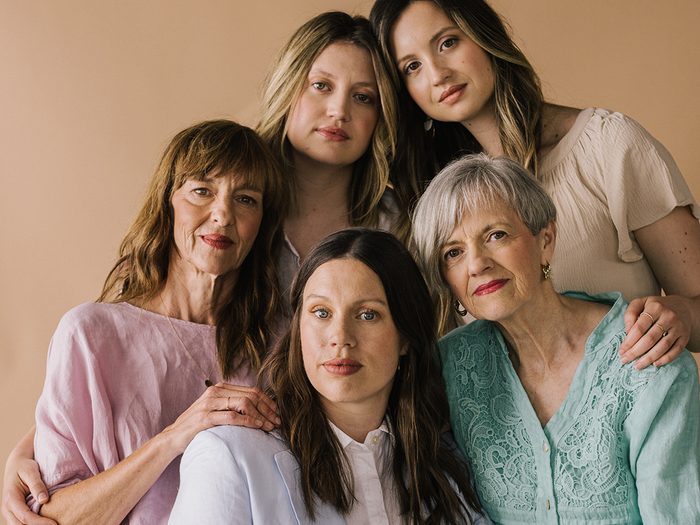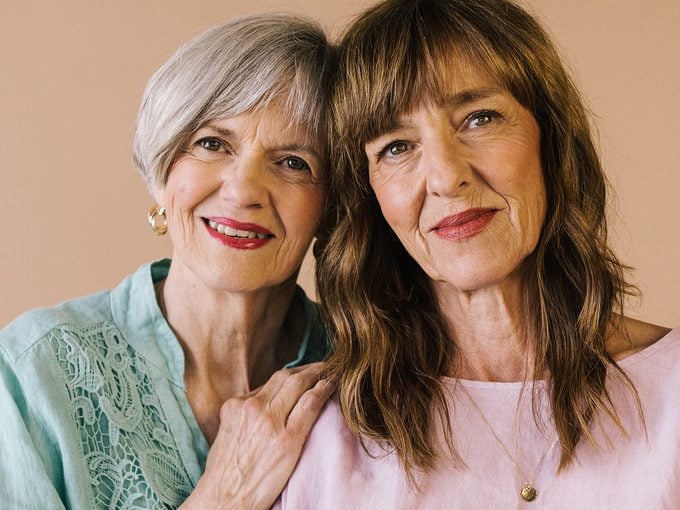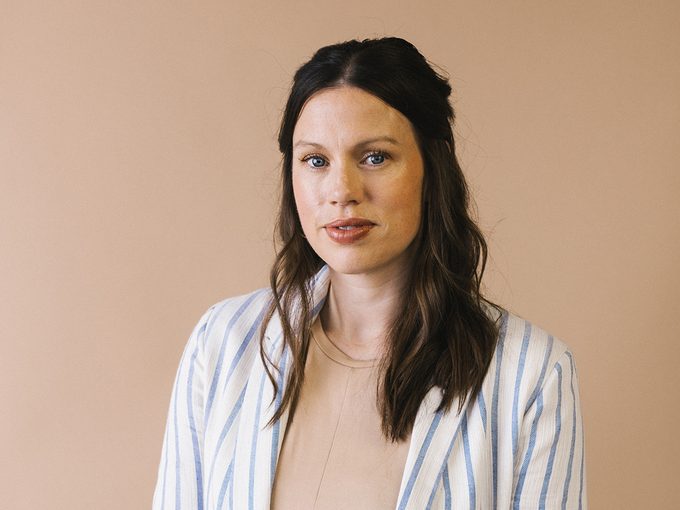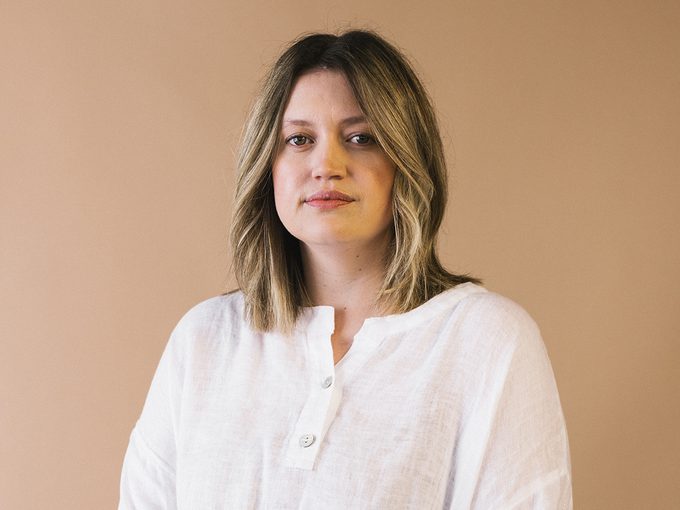“It Sometimes Seems Illogical to Stay in Nursing When I Could Earn More for Much Less Effort in Another Job”

Health care workers in Canada are currently fleeing the field, with one out of every four nurses planning to quit in the next three years. This multi-generational family of nurses has devoted their lives to the profession—what would it take to get them to stay?
Sarah Cleyn sometimes jokes that while she was in utero her mother, Maureen Farnand, used to whisper a mantra to her expanding belly: be a nurse…be a nurse…be a nurse. “I was born with the idea,” says Sarah, a 35-year-old palliative care nurse in Ottawa. “I’ve just always known what I was going to do.”
To be fair, nursing is a family calling: Sarah’s two sisters as well as her aunt, Annette Ashe, are also nurses, and her mom worked as a nurse from the late 1970s until she retired six years ago. Maureen chose the path in part through the encouragement of her own mother, who she believes “had probably always wanted to be a nurse. She had eight children, and I was her right-hand person.”
Maureen graduated from the University of Ottawa in 1976 with a Bachelor of Science in nursing (at the time, most nurses did their training through hospitals). She started out in orthopedics, moved into a post-cardiac ICU ward, held a day job in an outpatient clinic, supervised personal support workers as a community-health nurse, had a stint in a church and wrapped up her working life as a faculty advisor in the University of Ottawa nursing program.
For Maureen, the opportunity to balance career and family was a major draw of the job. “I have five children, and nursing meant I could contribute to our financial stability and also be an example for my daughters—that being a working mother is possible,” she says. She was grateful for the practical flexibility her career provided: she worked part time when Sarah was young, took time off when daughters Meghan and Mary (now an ICU nurse and an oncology nurse, respectively) came along, and then returned to community nursing as a parish nurse, a role that was outside the grind of shift work and so allowed her to be present for her kids.
That example was huge for Sarah, not only in terms of balance, but also in witnessing her mother’s pride, confidence, and competence. “It made me feel like I could take on the world,” she says. Being a nurse wasn’t just something her mother did at work: “She was a nurse in every aspect of her life, including in her mothering. She was kind and caring and supportive, but firm.” When Maureen visited Sarah’s elementary school to teach students about prenatal development, “watching her in action stirred a passion in me,” Sarah says. “I wanted to be like that!”
This translated into endless games of hospital, during which “Nurse Sarah” would tend to friends, schoolmates, and siblings—often taking accurate blood-pressure readings and checking heart rates with her mother’s gear. The middle child of five, Sarah was a natural caretaker and peacekeeper, and she eagerly took on the responsibility of looking out for Mary, six years her junior and the littlest in the family. (“Some might call it bossy,” Sarah says, “but I call it leadership!”) In her teens, a job as a lifeguard highlighted a knack for keeping her cool in chaotic situations; in the end, lifeguarding paid her way through nursing school at the University of Ottawa.
While Mary and Meghan first explored other areas at university, each was drawn into nursing about two years in: They both looked up to their mom and sister, and the clearest professional path seemed to be the one their family had already carved out. Sarah also married into a nursing family—her mother-in-law, Mary Pat Cleyn, was an RN until she retired around eight years ago, while her sister-in-law, Liz Cleyn, is a nurse in the internal medicine department at the Ottawa Hospital. The family has found it pretty handy that every group dinner is an opportunity to spitball ideas with an informal panel of nurses: They can share intel and support each other through the most inside-baseball (or inside-hospital) conundrums. But it also means that, for this crew, there’s really no separation between work and life.

Given all this exposure, Sarah had a solid sense of what she was in for when she chose her profession. “I knew I would be taking the good with the bad, that some days I would be run off my feet,” she says. But she believed her passion for nursing and her connection to her patients would outweigh any issues with staffing and pay. Instead, over the 14 years since she started out, the negatives have become amplified. Compared to her mom’s day, working in hospitals now means debilitating burnout, 12-plus-hour ER wait times, cancelled surgeries, and hostility toward health care workers. “Nursing has thrown me for a loop,” Sarah says. And though she and her sisters were raised to believe that this is their calling, they’ve also felt their frustration start to grow.
The tricky thing with a calling, Sarah says, “is that it almost validates the notion that you have to do this because you’re meant to do this.” But nursing is still a job. And you shouldn’t have to sacrifice your well-being for the sake of—maybe—making rent. It seems that this realization is sweeping the field: Nearly one in four Canadian nurses intend to quit in the next three years. As Sarah surveys a system on the brink of collapse, she finds herself questioning what lies ahead. “Nursing has always been about emptying your bucket more than you get it filled,” she says. “But now it’s like they’re asking for drops that just aren’t there.”

In 1966, a decade before Maureen graduated from nursing school, Canada introduced federal socialized health care. In short order, nursing underwent a significant shift in both responsibilities and public perception, with more emphasis on specialization and medicalization, rather than simply providing care. As the demand for nurses—and the demands on those nurses—across the country intensified, a labour movement began to organize. Although ad hoc collectives had existed within nursing since the 1940s, it wasn’t until the early ’70s that formal coalitions like the Ontario Nurses’ Association developed. In 1973, the Supreme Court of Canada established a precedent for nurses to form collective provincial bargaining units across the country.
In theory, the rise of organized labour meant that nurses could team up to advocate for better conditions, fair pay, and reasonable hours. And over the next two decades, nurses across the country did fight to improve their working environments. But then the early-’90s recession hit, leading provincial governments to reassess their budgets and put social services—including health care—through the austerity wringer. In Ontario, massive layoffs and hospital cutbacks meant that thousands of nurses were left jobless.
Michelle Johnson, a senior nurse at Mount Sinai Hospital in Toronto, has been watching the infrastructure erode since that recession. After Mike Harris became Ontario’s premier in 1995, “he decimated health care,” Johnson says. “He compared laid-off nurses to hula-hoop makers—he called us obsolete and said we needed to retrain so that we could do jobs that were relevant.” Subsequent Liberal governments made further devastating reductions. In Johnson’s 32 years of nursing, she says, “we haven’t actually ever had a significant raise.”
Bill 124 has worsened an already untenable situation for nurses in Ontario. That’s the legislation, brought by Doug Ford’s Progressive Conservative government in 2019, that limits wage increases for public-sector employees to no more than one percent annually over a three-year period. In many cases, this financial disincentive made it even less attractive for nurses to stay put in a foundering system. It compounded staffing issues and burnout in public health care at a particularly terrible time: Not even a year after Bill 124 passed, we were suddenly in a global pandemic.
COVID ratcheted up tensions in Sarah’s family as well. They especially fretted about Meghan, who had been working in the Ottawa Hospital ICU for less than a year when beds started to fill up with COVID patients. While ICU nursing felt like a “natural progression in my career,” Meghan says, she initially struggled with the stress and stakes of the job. “I feared I’d make mistakes, that I wouldn’t be smart enough or strong enough to endure the shifts.” Seven months in, she had just found her footing. But when the pandemic hit, “the fear, the doubt, and the stress all came crashing back.”
Meghan was rattled by both the volume of patients and the terrifying uncertainty of how to treat them and prevent transmission—especially early on, when PPE shortages meant she and her colleagues were stuck reusing their N95 masks. The worst part, she says, was the unknown: “Walking into work every day, not knowing what to expect.” She remains haunted by the final call she helped a young patient place to his wife, before she intubated him and put him on a ventilator. “It was unimaginable to think of this happening to my own family members,” she says.
As Maureen tried to comfort Meghan, who frequently called her in tears, she also worried about her daughters being exposed to something unknown. “I remember having gone through HIV, not knowing what that was. And then SARS—a couple of nurses died from that.” Despite that uncertainty, one of the hardest challenges that Sarah was facing was not volunteering to be on the front lines. With great difficulty, she prioritized the needs of her family, taking time off to be home with her kids, who are now eight, six, and four. But it’s a decision she still feels conflicted about. “It was a global pandemic. My skills were needed, and I felt I should be in there.”
While Mary’s position in an oncology clinic meant that she wasn’t directly caring for COVID patients, she nevertheless struggled to support people who, due to precautions, had no family or friends with them as they faced treatment—or even terminal diagnoses, which often came as a surprise because initial appointments were significantly delayed by the pandemic. The impact of these experiences hits her in waves. “As a nurse, no matter what your schedule is, there are shared difficulties that come with the heaviness of our roles. I’ve had to take a good amount of time outside of work to process these situations.” Most work environments, she adds, don’t expose people to the barrage of suffering, serious illness, and poverty that health care workers encounter on a daily basis.

According to Statistics Canada, there were 126,000 vacancies in the health care and social assistance sector, including registered and psychiatric nurses, in the last quarter of 2021—twice as many as in 2019, and a number that is only increasing as burnout, early retirement and the promise of better private-sector wages compel others to leave the field. Among all health care workers, nurses have reported the greatest declines in their mental health during the pandemic. (In another Statistics Canada survey, 37 percent of nurses described their mental health as “fair or poor,” compared to 27 percent of physicians.)
COVID has also made health care workers targets for people whose frustration with pandemic restrictions and requirements has coalesced into rage. Michelle Johnson notes that she and her colleagues have become alarmingly adept at calling security to manage angry patients and their family members. In three decades of nursing, she says, she’s never encountered this kind of hostility.
Media coverage of anti-vaccine protestors outside hospitals may have raised broader awareness of these conflicts, but that hasn’t translated into an increase in meaningful support on an institutional level. When the College of Nurses of Ontario (the field’s key regulatory body) shared the results of that StatsCan survey in a blog post, it threw in a few general resources: a link to crisis training, a mention of Employee Assistance Programs, and something called a “Self-Care Fact Sheet.” (It included suggestions like “improve work-life balance” or making dietary and activity-level changes “to help cope with stress.”) Sarah isn’t surprised by these bare-bones offerings. “I’ve never had anyone ask me, ‘Hey, how are you doing?’” she says. Even now, more than two years into the pandemic, there’s only minimal access to counselling available, despite the fact that nurses like Sarah and her colleagues are constantly dealing with death in a very real way.
“We’re in the middle of a global health crisis,” Johnson says. “Nurses can get a job anywhere. They’re offering massive incentives in the States. And here, we’re doing nothing.” There are supposed to be 50 full-time nursing staff on her unit; on average, they’re losing three a month. “We’ve lost well over half our full-time staff,” Johnson says. “They’re not coming back.” And there aren’t nearly enough bodies to cover for them. “Ontario graduates about 4,000 nurses a year. And right now, we’re roughly 30,000 nurses short.”
Because additional paid sick days, by some estimates, can amount to almost a half-percent salary bump—which, over three years, could easily push any “raise” past the 1 percent annual cut-off imposed by Bill 124—expanding leave for nurses is not an option, meaning they’re stuck taking unpaid sick days or working while ill. Which is to say: We’re treating the people who’ve been on the health care front lines throughout the pandemic—the ones who’ve inspired us to bang pots, make signs, and deliver pizzas for sustenance—as though they’re expendable, at a time when society needs them the most.
The effects of Bill 124 have become even more crushing as the cost of living has ballooned. In June of 2022, Canada’s annual inflation rate hit 8.1 percent, the highest it’s been since 1983. In practical terms, that means you’d need about $45 today to buy what you could have purchased with $40 in 2019—so a nurse whose salary has remained the same over that period is being paid less now, in relative terms. “Being praised can be helpful for job satisfaction and morale,” Mary says. “But when it comes down to it, how is value placed on our work? It’s in our status and in our salary.”

Since graduating a decade and a half ago, Sarah has worked as a nurse in many areas, from internal medicine to a stint in the ICU to her current palliative role. At no point has she worked on a unit that has been fully staffed. Sure, she says, she and her peers do what they can to find creative ways around their limitations. But it’s exhausting—and for Sarah, a mother of three young kids, taking on ever-expanding shifts to cover staff shortages isn’t feasible.
Sarah admits that she’s had moments where she’s toyed with the idea of finding a new job in a different field. Her sisters have wrestled with similar feelings. At times, Mary has seriously questioned why she remains in nursing. “There are massive learning curves that can often feel insurmountable,” she says. Early in her career, Mary was struck by a patient and sustained a concussion; the violence led her to search for a role that didn’t involve bedside care. “It sometimes seems illogical to stay in this incredibly challenging job when I could earn more for much less effort,” she says.
For Sarah, finding a sustainable way to be a nurse may mean moving away from the hands-on care that first drew her to the field and taking on a new role—one that could provide the sort of leadership and advocacy the profession sorely needs. After a recent promotion, she has become the advanced practice nurse for her team, which means she’s now a manager. She has a true passion for palliative care—it’s fulfilling, she says, to help patients navigate terminal illnesses, and to provide direct bereavement support to families—and she’s worried about moving away from that work as she assumes the obligations that come with a leadership role.
Yet, Sarah says she feels hopeful about the change she can make in this position. In her mom’s day, nurses put down their heads and did whatever it took to get the job done. From Sarah’s perspective, that’s no longer possible today. She wants to break down barriers between different departments so nurses can share information and make their jobs more efficient. She wants to fight for equal pay. She wants to empower nurses to access further education. She wants to push for cultural competence training, so nurses can provide end-of-life care to patients whose values and beliefs lie outside of Judeo-Christian traditions. She wants to advocate for a greater focus on wellness. “The last six months is probably the first time that I’ve heard colleagues even talking about their mental health, which is wild,” she says. “You’d think, especially in palliative care, that we’d debrief, but we never talk about how we’re doing as people.”
Sarah knows she can’t fix a broken system overnight. But as someone who gets what it’s like in the trenches—and who now has more power and autonomy—she can improve the work life of the people around her.
“I can’t in my heart of hearts leave nursing without knowing that I did everything that I could to make it better not just for myself, but for everyone else,” she says. And Sarah has faith that change is possible. She sees it in newer nurses, who have more confidence to stand up for themselves. She believes the pandemic has given the public a better understanding of how valuable nursing is as a profession. She can feel a culture shift on the horizon. She’d even like her kids to take up the family calling, she says: “I would be proud to watch them become nurses and carry on this amazing legacy.”
Next: I Need You to Know that Good Relationships Are Vital to Good Health Care




